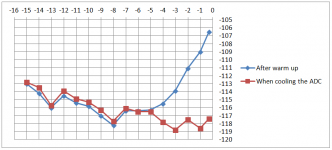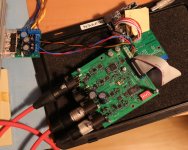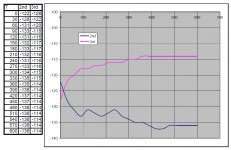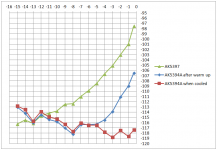I have measured the distortion of the AK5394A versus the level. With and without "cooling".
The cooling was done by blowing on the ADC through a straw. Without cooling the surface temperature of the ADC seems to be around 65 degrees C, measured with an IR thermometer.
After power ON I had previously seen some fairly high levels of distortion. I now think that this may be related to the initial internal calibration. The reset timing is fairly long, but perhaps not quite long enough. In case of problems I gave it a manual reset. So I think that it is probably OK (right after power ON) as long as the initial calibration is done correctly.
The figure below shows the distortion with and without cooling. There definitely seems to be an advantage in cooling the ADC.
The X-axis shows the measured level in dBFS. The levels measured range from -15dBFS to -0.3dBFS.
The Y-axis shows the distortion (THD) in dB.
The generator was a Stanford Research DS360.
The results have improved a lot. At high levels they may even be limited by the distortion of the DS360.
It would be interesting to find out if others can verify these results in other setups.
The cooling was done by blowing on the ADC through a straw. Without cooling the surface temperature of the ADC seems to be around 65 degrees C, measured with an IR thermometer.
After power ON I had previously seen some fairly high levels of distortion. I now think that this may be related to the initial internal calibration. The reset timing is fairly long, but perhaps not quite long enough. In case of problems I gave it a manual reset. So I think that it is probably OK (right after power ON) as long as the initial calibration is done correctly.
The figure below shows the distortion with and without cooling. There definitely seems to be an advantage in cooling the ADC.
The X-axis shows the measured level in dBFS. The levels measured range from -15dBFS to -0.3dBFS.
The Y-axis shows the distortion (THD) in dB.
The generator was a Stanford Research DS360.
The results have improved a lot. At high levels they may even be limited by the distortion of the DS360.
It would be interesting to find out if others can verify these results in other setups.
Attachments
I have measured the distortion of the AK5394A versus the level. With and without "cooling".
To cool down an oven is may the false direction.
Interesting would be to add in your sheet, how does the AK5397 performs compared to the AK5394A.
Or in other words your AK5397 use is already gone?
Thanks
Hp
Well, a PC processor is normally also cooled. So it is not uncommon 
The measurements on the AK5394A were done on a design I made last year. The basic concepts are the same, but the input and output stages are much simpler. And parts of the power supply are off-board. I have attached a picture below.
Hopefully I will find the time to make the same measurements on the AK5397 board soon.
I have not made a final decision regarding AK5394A/AK5397. I am also waiting for some feedback from AKM. But with the data in the data sheet, my preliminary measurements and the comments from Demian:
I am worried that we will perhaps never get the same performance. A large dynamic range and a high sample rate option is nice, but if the distortion is too high, it will be a problem.
Hopefully this can be cleared up in the near future.
The measurements on the AK5394A were done on a design I made last year. The basic concepts are the same, but the input and output stages are much simpler. And parts of the power supply are off-board. I have attached a picture below.
Hopefully I will find the time to make the same measurements on the AK5397 board soon.
I have not made a final decision regarding AK5394A/AK5397. I am also waiting for some feedback from AKM. But with the data in the data sheet, my preliminary measurements and the comments from Demian:
Originally Posted by 1audio
AKM has said the AK5397 is not as low distortion as the AK5394A when pressed but I'm sure there are some techniques to get the distortion lower to be discovered. The AK5394A performance is quite exceptional.
I am worried that we will perhaps never get the same performance. A large dynamic range and a high sample rate option is nice, but if the distortion is too high, it will be a problem.
Hopefully this can be cleared up in the near future.
Attachments
JensH - do you have a possibility, to try another 5394?
I make some measurements, and even I have seen the tempersture/puwer_up issu, my results are not correlate with yours.
Measurements were taken at -1dBFS, signal from Victor's generator.
See the picture - the 2nd harmonic drops from -122 to -136dBFS, the 3rd - rise from -128 to -114dBFS.
Graph sows the first 5 min. after power up.
After 20 min, 2nd harmonic level was ~-139-140, the 3rd - -114dBFS.
When I worm the chip with the blower, the 2nd rise to -120 and the 3rd - to -100, but it was extremally high temperatire (I think >80C).
P.S. Experiment with overclocking failed, 5394 not works at 352/384 with 22/24MHz MCLK with any DFS0/DFS1 combination.
It's a pity, because AK's DACs are overclocked succesfully - I run AK4399, AK4414 384kHz PCM and DSD128 (datasheet's limits are 192 and DSD64).
I make some measurements, and even I have seen the tempersture/puwer_up issu, my results are not correlate with yours.
Measurements were taken at -1dBFS, signal from Victor's generator.
See the picture - the 2nd harmonic drops from -122 to -136dBFS, the 3rd - rise from -128 to -114dBFS.
Graph sows the first 5 min. after power up.
After 20 min, 2nd harmonic level was ~-139-140, the 3rd - -114dBFS.
When I worm the chip with the blower, the 2nd rise to -120 and the 3rd - to -100, but it was extremally high temperatire (I think >80C).
P.S. Experiment with overclocking failed, 5394 not works at 352/384 with 22/24MHz MCLK with any DFS0/DFS1 combination.
It's a pity, because AK's DACs are overclocked succesfully - I run AK4399, AK4414 384kHz PCM and DSD128 (datasheet's limits are 192 and DSD64).
Attachments
Last edited:
I do have some spare AK5394A's. But they are not mounted at the moment. I plan to either cut out a part of the PCB shown in the previous post or perhaps make a small PCB with just the ADC and a couple of LDO's + passive components around the ADC. This could then be used in a test to replace the AK5397 in the larger design,
At least your tests also show a strong temperature dependence. Your second harmonic goes to much lower levels, but my measurements may be limited by the performance of the generator. It does seem like the OPA1632 input circuit that I have prefers a differential input. With single ended inputs (from either my 1kHz low distortion generator or the VP7722A) I see increased distortion at high levels.
A difference in the sensitivity to warming up (temperature increase) could perhaps be caused by the PCB's. Perhaps your PCB has a better heat distribution than mine? Or gets warmed up less from surrounding circuits?
At least your tests also show a strong temperature dependence. Your second harmonic goes to much lower levels, but my measurements may be limited by the performance of the generator. It does seem like the OPA1632 input circuit that I have prefers a differential input. With single ended inputs (from either my 1kHz low distortion generator or the VP7722A) I see increased distortion at high levels.
A difference in the sensitivity to warming up (temperature increase) could perhaps be caused by the PCB's. Perhaps your PCB has a better heat distribution than mine? Or gets warmed up less from surrounding circuits?
I made these measurements with SE input.
I also tried to cool down the chip with the freezer spray: 2nd rise to -112, 3rd - to -105.
P.S. My surrounding circuits, at least from two sides, produces a lot of heat - at one side galvanically isolated USB part is located. Where to avoid the тщшыу I do not useв switched DC/DC to power XMOS chip (1V VDD from 5V USB), all regulators are linear. And at the second side I have 3xTO-220 heatsinks of the voltage splitter and regulator, to power the analog part.
So, there are lot of heat inside the case.
P.P.S I sent to Damien the same ADC board a year ago, but unfortunately, something happend during the shipping, and he can't run it.
I also tried to cool down the chip with the freezer spray: 2nd rise to -112, 3rd - to -105.
P.S. My surrounding circuits, at least from two sides, produces a lot of heat - at one side galvanically isolated USB part is located. Where to avoid the тщшыу I do not useв switched DC/DC to power XMOS chip (1V VDD from 5V USB), all regulators are linear. And at the second side I have 3xTO-220 heatsinks of the voltage splitter and regulator, to power the analog part.
So, there are lot of heat inside the case.
P.P.S I sent to Damien the same ADC board a year ago, but unfortunately, something happend during the shipping, and he can't run it.
Last edited:
So there seems to be some kind of sweet spot in terms of temperature.
I have just made some measurements on the new AK5397 based design for comparison.
The good news is that the AK5397 seems to be very stable over temperature
The bad news is that the distortion, at least in this setup, is much higher
The input circuits are quite different, but I think that the input stage in front of the AK5397 should be OK. On a test board that I made some time ago, I measured a distortion of around -132dB at 10dBV input.
I have used a design based on LME49990 to drive the ADC. In the AK5397 data sheet this op-amp actually seems to deliver poorer distortion performance than the LME49710, which is very strange. So there may still be room for improvements.
I have attached the comparison of the AK5397 and AK5394A results.
I have just made some measurements on the new AK5397 based design for comparison.
The good news is that the AK5397 seems to be very stable over temperature
The bad news is that the distortion, at least in this setup, is much higher
The input circuits are quite different, but I think that the input stage in front of the AK5397 should be OK. On a test board that I made some time ago, I measured a distortion of around -132dB at 10dBV input.
I have used a design based on LME49990 to drive the ADC. In the AK5397 data sheet this op-amp actually seems to deliver poorer distortion performance than the LME49710, which is very strange. So there may still be room for improvements.
I have attached the comparison of the AK5397 and AK5394A results.
Attachments
I don't know of anyone who has something available in this form except AKM, and they are not cheap but the demo board with mods is very good.
The EMU 1212m, 1616m and 1812m all use this ADC. The 1212m is a pci or pcie card set so its pretty easy to tweak. The 1616m is far less tweak compatible. Its difficult to open (the knobs are glued on) and cannot be operated open since the two PCB's are sandwiched in a way that makes it not useful to try. I have two fried examples from assembly mistakes. The parts that fry will be the switching power controller and the big FPGA. I tried to repair one and it went nowhere. It has 6 inputs and 3 AK5394A inside plus a pretty complex array of opamps to support it. I think it needs something like 20 duals for a complete upgrade. otherwise its a great platform with complete isolation from the host, enormous flexibility, excellent design and execution. I suspect replacing the JRC opamps with better opamps would get better sound as well.
I believe some of the Lynx cards use that ADC as well as does the Protools stuff.
We can hope that either Jen's or Alex get to a point where they want to sell something.
As soon as my shop is functional I'll try to get the Altor ADC running. I have been down for almost 8 months since moving and its driving me crazy.
The EMU 1212m, 1616m and 1812m all use this ADC. The 1212m is a pci or pcie card set so its pretty easy to tweak. The 1616m is far less tweak compatible. Its difficult to open (the knobs are glued on) and cannot be operated open since the two PCB's are sandwiched in a way that makes it not useful to try. I have two fried examples from assembly mistakes. The parts that fry will be the switching power controller and the big FPGA. I tried to repair one and it went nowhere. It has 6 inputs and 3 AK5394A inside plus a pretty complex array of opamps to support it. I think it needs something like 20 duals for a complete upgrade. otherwise its a great platform with complete isolation from the host, enormous flexibility, excellent design and execution. I suspect replacing the JRC opamps with better opamps would get better sound as well.
I believe some of the Lynx cards use that ADC as well as does the Protools stuff.
We can hope that either Jen's or Alex get to a point where they want to sell something.
As soon as my shop is functional I'll try to get the Altor ADC running. I have been down for almost 8 months since moving and its driving me crazy.
Demian, I found a new(!) 1616 recently, and I also have the m version. The boards are identical, and are only mounted by different ADC and DAC, plus some small differences in components. On order are 3 AK5394A and some cirrus chips so that I can replace the old population of the non-m. At the same time I am going to put in some OPA1612's, so who knows where that will end. I tested the gate arrays of both and they seem to be interchangeable.
Just a question because you made me worried. What did you do to fry two of them? You no fool, so where is the slippery part?
Just a question because you made me worried. What did you do to fry two of them? You no fool, so where is the slippery part?
Its getting all the pins lied up when reassembling. Its easy to miss by 1 pin in any of 4 axis. The problem being no shroud and 25 mm separation so everything mechanical can line up with the pins out of alignment. its very hard to see with the chassis. Next time I'll ring out some connections to make sure they line up.
Upgrading a 1616 with new ADC's may or may not work. The ADC is wire programmed so it may work. The DAC's are probably programmed through the I2C so that's more problematic. I would send you one of my dead PCB's to follow but your a little too far.
I'm not sure its possible to mix 1616 and 1616m boards. I think I tried but its been a while. I saw a detailed reverse engineering of the 0404 USB which hints at the actual input circuitry of the 1616m. The relays and multilayer PCB's just made reversing too overwhelming on the 1616 platform.
Upgrading a 1616 with new ADC's may or may not work. The ADC is wire programmed so it may work. The DAC's are probably programmed through the I2C so that's more problematic. I would send you one of my dead PCB's to follow but your a little too far.
I'm not sure its possible to mix 1616 and 1616m boards. I think I tried but its been a while. I saw a detailed reverse engineering of the 0404 USB which hints at the actual input circuitry of the 1616m. The relays and multilayer PCB's just made reversing too overwhelming on the 1616 platform.
It is the dream of most audio designers to own Audio Precision gear and your project leads toward that achievement so press on and good luck. I understand that AP uses AD797 opamps in the front end. Jens please go into production when you are satisfied with the performance. Count me as a future customer.
@jcdrisc
At the moment I am concentrating on getting the performance where it should be. I have not yet looked at how much it will cost or how and when to set up the production.
I will be an nice tool to have.
About the implementation of the AK5394A in the Emu cards: i have a doubt about the 1616m heat transfer capabilities. The whole unit is getting hot, which is even quite normal given the high number of channels. In the light of JensH latest results, it could be a problem when trying to squeeze it for the best distortion levels. Force cooling?
Also the clock should be somehow revisited, that is really not the best.
Due to the warnings of Demian I was extra careful about the alignment of the connectors. Thanks! George
Also the clock should be somehow revisited, that is really not the best.
Due to the warnings of Demian I was extra careful about the alignment of the connectors. Thanks! George
Good point about heat in the 1616m. That may explain the less consistent results I was getting. ideally a Peltier cooler set to the optimum temperature. Probably easier to go with a seperate board solution. Linking with SPDIF works great (Link jitter is a non issue there)
- Home
- Design & Build
- Equipment & Tools
- DIY Audio Analyzer with AK5397/AK5394A and AK4490



